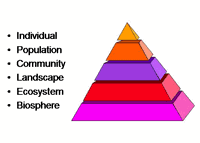|  |
|
HOW BAD TIMES HOW OFTEN Risk as Science Dr. Robert K. D. Peterson
Agricultural & Biological Risk Assessment
Montana State University
bpeterson@montana.edu |  |
|
Risk as Science
In the article Risk as Perception, we saw how risk is a function of personal perceptions. One way to write this is: risk = ƒ(perceptions). The science-based assessment of risk can be written as: risk = ƒ(hazard, exposure). Given that definition, it is now necessary to define “hazard” and “exposure.” |
|
Hazard
A hazard is the inherent ability of a substance or activity to cause harm. The following are examples of hazards:
- benzene can cause leukemia
- benzene does not cause lung cancer
- methyl parathion is a neurotoxin
- permethrin is toxic to fish
- playing American football can result in broken bones among participants
- table salt is toxic to humans
- the Bacillus thuringiensis protein toxin genetically engineered in corn is toxic to certain butterfly and moth caterpillars
Every substance and activity has the potential to cause harm. Therefore, everything is a hazard. Some substances or activities have the potential to cause several different types of harm, but many others cause only one or a few types of harm. For example, the weight-of-scientific-evidence indicates that benzene does not cause lung cancer, but benzene is still a hazard because it can cause leukemia. Similarly, playing football does not result in a neurotoxicity of the human nervous system, but it can result in neurological problems as a result of physical impact and stress.
|
Class Exercise - What is a Hazard?
Ask your students what substances or activities do not represent a hazard. A student or two may state that drinking water does not represent a hazard because water is not toxic. However, water is indeed toxic and excess water intake (overhydration) can result in reversible toxic effects in adults and irreversible effects in newborn children. For adults, overhydration can lead to hyponatremia (low blood sodium concentrations). Symptoms of hyponatremia include nausea, fatigue, confusion, and seizures. For newborns, formula overdiluted with water can result in irreversible kidney damage.
Another student or two may say that brushing your teeth does not represent a hazard. However, toothpaste is toxic; just look at the warnings on the toothpaste tube. Also, brushing your teeth has the possibility of opening wounds which may result in bacterial infection. Of course, not brushing your teeth also is a hazard.
But hazard alone is not risk. Does every participant who plays football experience a broken bone each time he or she plays? Does ingestion of 1 mg of table salt harm a person? Remember, risk is a function of both hazard and exposure. So, to assess risk, we need to understand the amount of exposure or the probability of exposure to the hazard.
|
|
Exposure
 Exposure is the probability and/or amount of contact between the hazard and the entity it is potentially harming. What is the probability that a person will experience a broken bone in a backyard game of football? Does the probability change if the person is playing as a team member on a high school, college, or professional football team? Does the probability change if the person is playing in freezing or wet conditions? Exposure is the probability and/or amount of contact between the hazard and the entity it is potentially harming. What is the probability that a person will experience a broken bone in a backyard game of football? Does the probability change if the person is playing as a team member on a high school, college, or professional football team? Does the probability change if the person is playing in freezing or wet conditions?
In our table salt example, what is the amount of salt you ingest every day and how does that relate to the harmful effects of salt. Similarly, what is the probability that you will consume enough table salt necessary to kill you?
|
|
Risk is Really About Probabilities
Hazard is about possibilities and
risk is about probabilities. Because everything is a hazard, everything entails some degree of risk. But risks vary dramatically because of differences in the severity of the hazard and in the probability of exposure. In short, risk is “how bad X how much.”
Expressing Risk
How is risk expressed? What does a risk statement look like? Because risk is most often a probability of harm, the risk expression may look like the following examples:
- 1 in 70 lifetime chance of dying in a car accident
- 1 in 10 million lifetime chance of cancer from a five-year exposure to the chemical
- exposure to chloroform in drinking water at 1 part per billion for a lifetime is associated with worst case an (what does upper-bound mean? Can you provide definition?) upper-bound increase in cancer risk of 1.7 in 10,000,000
- 99.5% of the wildlife species will not be affected by the environmental contaminant
|
Class Exercise - Demonstration of Risk as a Function of Hazard and Exposure
 Fill a salt shaker with about 3 tablespoons of table salt and place the lid on it. Relate to the students that three tablespoons of salt when ingested is a sufficient dose to kill a child under about 40 pounds, and either kill an adult or make her very ill. So, in effect, you are holding a hazardous substance in your hand. The hazard is present and the hazard is real. Fill a salt shaker with about 3 tablespoons of table salt and place the lid on it. Relate to the students that three tablespoons of salt when ingested is a sufficient dose to kill a child under about 40 pounds, and either kill an adult or make her very ill. So, in effect, you are holding a hazardous substance in your hand. The hazard is present and the hazard is real.
Now ask the students what is the probability that they will exposed to the salt as long as it remains in the shaker. The probability of exposure is extremely low, so the risk is extremely low. Sprinkle a little salt on the floor and on a few student desks. Now ask the students what their exposure is. Is it still as low as when the salt remained in the shaker? No, but is their exposure sufficient to cause harm? What is the probability that they will ingest the salt on the floor and on the table? How much would be ingested? Hopefully, they will see that their exposure (via ingestion) is extremely small and therefore their risk of harm from salt is extremely small. Even if the salt shaker broke open and all of the salt spilled onto a table, the exposure still would not be sufficient to cause harm.
Ask the students to imagine a scenario where the salt could cause harm. If the salt shaker was accidentally left in the classroom and the next class consisted of two-year old children, one of the children could ingest enough salt to cause harm.
|
The examples above all refer to probabilities. However, risk also can be expressed in other terms. For example, in pesticide or biotechnology crop risk assessment, we may be interested in exposure to the substance relative to a regulatory threshold value(a regulatory threshold is the maximum exposure allowable, as determined by regulatory authorities). In that case, the risk statement of interest is whether the exposure is over or under the regulatory threshold. An example statement may be: A one-day dietary exposure to methyl parathion (insecticide) results in 4% of the EPA acceptable daily intake. This is not the same thing as saying that you have a 4% probability of harm from dietary exposure to methyl parathion. It really says that your dietary exposure is 96% below the acceptable daily intake threshold. But, you can still relate the statement to a probability by including a distribution of dietary intakes for a population of people. The average may be 4% of the acceptable daily intake, but 1 out of 1,000 people may be exposed to more than 100% of the acceptable daily intake. Therefore, you might state that 0.1% of the population may be exposed to unacceptable levels of methyl parathion.
Scale and Risk
 Risks may affect single or multiple levels of biological or ecological organization. For example, a pesticide sprayed only on 100 acres may affect individuals and populations of organisms, but it may not affect the entire landscape or agroecosystem. Climate change, on the other hand, may affect all levels, from individuals to the entire biosphere. In the case of corn (maize) genetically engineered to contain an insecticidal protein from the bacterium, Bacillus thuringiensis, the pollen may affect individual monarch butterfly caterpillars within the field, but it may not affect the population of monarchs in the same geographic area. Risks may affect single or multiple levels of biological or ecological organization. For example, a pesticide sprayed only on 100 acres may affect individuals and populations of organisms, but it may not affect the entire landscape or agroecosystem. Climate change, on the other hand, may affect all levels, from individuals to the entire biosphere. In the case of corn (maize) genetically engineered to contain an insecticidal protein from the bacterium, Bacillus thuringiensis, the pollen may affect individual monarch butterfly caterpillars within the field, but it may not affect the population of monarchs in the same geographic area.
 In this section, we have seen how risk is a function of both hazard and exposure. And, we have seen that risks vary depending on the severity of the hazard and the probability or amount of exposure. Conceptually, the science-based definition of risk is rather simple and straightforward. In practice, however, the assessment of risk can be extremely complicated and difficult.
In this section, we have seen how risk is a function of both hazard and exposure. And, we have seen that risks vary depending on the severity of the hazard and the probability or amount of exposure. Conceptually, the science-based definition of risk is rather simple and straightforward. In practice, however, the assessment of risk can be extremely complicated and difficult.
Next Section: I KNOW WHAT RISK IS, BUT HOW DO I ASSESS IT?
The Risk Assessment Paradigm
|
|











